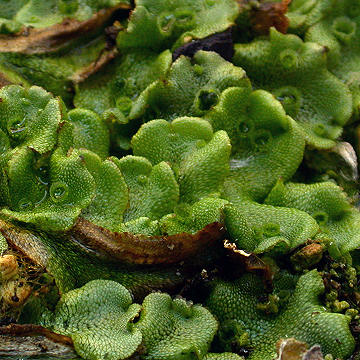

Marchantia polymorpha - (image 1 of 8)
Taxonomy
Family: Marchantiaceae
Habitat
Moist to wet, subcalcareous mineral soil. Best growth is obtained in full sunlight but will tolerate some shade. Colonizes readily after fire via spores.
Associates
Distribution
Widespread
Morphology
Large, thallose, dioecious liverwort; thallus dichotomously branched, to 10 cm long and 2 cm wide, with many fine rhizoids that anchor it to the soil. Antheridiophores and archegoniophores umbrella-like, the latter more deeply lobed; spores with hygroscopic elators that aid in dispersal. Vegetative reproduction can occur via fragmentation of the thallus or dispersal of gemmae from gemma cups.
Notes
Gametophores produced in May; sporangia in July.
Wetland indicator: NA
This is a common liverwort of disturbed habitats. Considered a weed of nurseries and greenhouses as it thrives in the conditions created by sprinklers and misting systems. It is easily grown in a terrarium with moderate light, although gametangia are only produced in high light conditions.
key to images
References
Matthews, Robin F. 1993. Marchantia polymorpha. In: Fire
Effects Information System, [Online].
U.S. Department of Agriculture, Forest Service, Rocky Mountain Research Station,
Fire Sciences Laboratory (Producer).
Available: http://www.fs.fed.us/database/feis/ [].
USDA, NRCS. 2002.
The PLANTS Database, Version 3.5 (http://plants.usda.gov).
National Plant Data Center, Baton Rouge, LA 70874-4490 USA.
|
Michael Hough © 2010 |